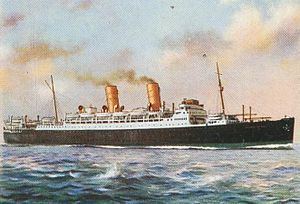Yard number 524 Length 183 m | Port of registry London, UK Launched 28 September 1928 Builder John Brown & Company | |
 | ||
Owner Canadian Pacific Steamships Route | ||
SS Duchess of York was a 20,021 ton ocean liner operated by the Canadian Pacific Steamship Company. Built in 1928 in Clydebank by the shipbuilders John Brown & Company, she was originally intended to be named Duchess of Cornwall. However agreement was reached with Red Funnel company to swap names with the latter's paddle steamer Duchess of York, launched in 1896.
Contents
She was sunk in 1943 off Spain after being damaged by long range German bombers.
Pre-war service
Duchess of York was one of the several sturdy Canadian Pacific liners which were known as the "Drunken Duchesses" for their lively performance in heavy seas. She was built as a sister ship to the SS Duchess of Bedford, the SS Duchess of Atholl, and the SS Duchess of Richmond. The vessel was created for transatlantic service; and she was employed on the Liverpool to Quebec and Montreal route. During the winter months when the St. Lawrence was frozen (typically November to April), she sailed to Saint John, New Brunswick.
Her first captain between 1929 and 1934 was Ronald Niel Stuart, VC whose First World War service record entitled him to fly the Blue Ensign whilst he was aboard. Following his departure, the liner was employed briefly on the New York CIty to Bermuda route before returning to her original passage.
War service and loss
In 1940, Duchess of York left Greenock on 27 July 1940, bound for Halifax taking evacuated children under the Children's Overseas Reception Board. She returned to England and made a second trip taking another batch of children from Liverpool on 10 August 1940, bound for Canada.
She was recommissioned by the British Admiralty as a troopship and used early in the war to transport Canadian soldiers to Britain, returning to Canada carrying RAF aircrew and German prisoners of war (among them legendary escapee Franz von Werra in early January 1941). On 9 July 1943, she sailed Greenock as part of the small, fast Convoy Faith, for Freetown, Sierra Leone, in company with the SS California and the merchant ship Port Fairy.
Two days later, the convoy was about 300 miles west of Vigo when it was attacked by three Focke-Wulf Fw 200 aircraft of Kampfgeschwader 40 based at Merignac near Bordeaux. The accurate high-altitude bombing left both Duchess of York and California blazing. Her escorts HMCS Iroquois, HMS Douglas and HMS Moyola, together with Port Fairy, rescued all but twenty seven from the ship. Fearing the flames from the ships would attract U boats, Duchess of York and California were sunk by Royal Navy torpedoes in position 41°15′N 15°24′W in the early hours of 12 July.
